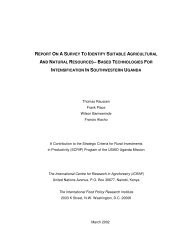Continuities in environmental narratives, Kabale, Uganda ... - Foodnet
Continuities in environmental narratives, Kabale, Uganda ... - Foodnet
Continuities in environmental narratives, Kabale, Uganda ... - Foodnet
You also want an ePaper? Increase the reach of your titles
YUMPU automatically turns print PDFs into web optimized ePapers that Google loves.
ecome so widely believed that it is written <strong>in</strong>to reports without adequate substantiation,<br />
commenc<strong>in</strong>g a cycle <strong>in</strong> which such reports are then cited <strong>in</strong> subsequent documents thereby<br />
re<strong>in</strong>forc<strong>in</strong>g the prevail<strong>in</strong>g perceptions without valid confirmation. The few studies that report<br />
evidence contrary to the prevail<strong>in</strong>g beliefs of overpopulation and land degradation either fail to<br />
perceive their results as contradict<strong>in</strong>g the conventional wisdom or are simply not noticed<br />
amongst the overwhelm<strong>in</strong>g body of op<strong>in</strong>ion repeat<strong>in</strong>g the received wisdoms.<br />
Agroforestry.<br />
For over two decades agroforestry has been promoted as a ‘practical and beneficial landuse<br />
system for smallholders’ 87 and a number of developmental agencies work<strong>in</strong>g <strong>in</strong> <strong>Kabale</strong> today<br />
have projects with an agroforestry component, <strong>in</strong>clud<strong>in</strong>g ICRAF/AFRENA, Africare and Africa<br />
2000. The overrid<strong>in</strong>g assumption that drives this policy is that deforestation has occurred <strong>in</strong><br />
<strong>Kabale</strong> and cont<strong>in</strong>ues to occur. Thus, for example, the National Soils Policy for <strong>Uganda</strong> has<br />
observed that ‘erosion… is particularly severe <strong>in</strong> … <strong>Kabale</strong> … where high altitude mounta<strong>in</strong><br />
slopes have been greatly deforested.’ 88 A large NGO work<strong>in</strong>g <strong>in</strong> the area states (without cit<strong>in</strong>g<br />
any evidence) that ‘deforestation is widely practiced.’ 89 The 1998 State of the Environment<br />
Report noted that ‘expansion of agriculture on previously forested steep terra<strong>in</strong>s has led to soil<br />
erosion … districts seriously affected [<strong>in</strong>clude] <strong>Kabale</strong>.’ 90 The District Environment Profile<br />
blames woodfuel demand: ‘The high demand for woodfuel has resulted <strong>in</strong> destruction of many<br />
<strong>in</strong>digenous forests <strong>in</strong> the district. Some valuable trees such as black wattle (acacia mearnsii)<br />
have been lost and besides this serious soil erosion is already be<strong>in</strong>g experienced. Some hills are<br />
bare and have exposed rocks.’ 91<br />
But what is the history of tree cover <strong>in</strong> the area? There is evidence that the area has not<br />
been deforested over the past century; rather this occurred much longer ago. Clear<strong>in</strong>g of forests <strong>in</strong><br />
the <strong>Kabale</strong> area started more that 4,800 years ago with further clear<strong>in</strong>g around 2,200 years ago 92 and<br />
agriculture concomitant with more permanent settlements was probably established around 2,000<br />
years ago. 93 By the time of the arrival of colonial officials forests had long been cleared <strong>in</strong> <strong>Kabale</strong><br />
and thus the population <strong>in</strong>crease of the past century cannot be blamed for the deforestation of the<br />
district. As Hamilton et al have noted ‘major degradation of the environment by man occurred early<br />
at this locality.’ 94<br />
87 G.L. Denn<strong>in</strong>g, ‘Realis<strong>in</strong>g the potential of agroforestry: <strong>in</strong>tegrat<strong>in</strong>g research and development to achieve greater<br />
impact’ Development <strong>in</strong> Practice, 11 4, (2001), 404-16.<br />
88 NEMA, ‘The National Soils Policy for <strong>Uganda</strong>’ (1998), 16.<br />
89 Africare Basel<strong>in</strong>e Survey (1997), 45.<br />
90 NEMA, State of the Environment Report for <strong>Uganda</strong> 1998, 76.<br />
91 <strong>Kabale</strong> District Environment Profile (1995), 34.<br />
92 A. Hamilton, et al ‘Early forest clearance and <strong>environmental</strong> degradation <strong>in</strong> South West <strong>Uganda</strong>,’ Nature, 320,<br />
(1986), 164-7.<br />
93 D. Taylor and R Marchant ‘Human impact <strong>in</strong> south-west <strong>Uganda</strong>: long term records from the Rukiga highlands,<br />
Kigezi’, Azania 29-30, (1994-95), 283-95. D. Taylor, ‘Late quaternary pollen records from two <strong>Uganda</strong> mires:<br />
Evidence for <strong>environmental</strong> change <strong>in</strong> the Rukiga highlands of southwest <strong>Uganda</strong>’, Palaeogeography,<br />
Palaeobotany and Palynology, 80 (1990), 283-300. See also P. Robertshaw and D. Taylor ’Climate change and<br />
the rise of political complexity <strong>in</strong> western <strong>Uganda</strong>’ Journal of African History, 41 1, (2000) 1-28 and D.L.<br />
Schoenbrun, ‘The contours of vegetation change and human agency <strong>in</strong> Eastern Africa’s Great Lakes region: ca<br />
2000 BC to cs AD 1000’, History <strong>in</strong> Africa, 21, (1994), 302.<br />
94 Hamilton, et al ‘Early forest clearance’.<br />
D:\_<strong>Uganda</strong> Land Use\SW land use and soils\Carswell papers\Carswell- Narratives paper-17 Dec.doc<br />
17
















